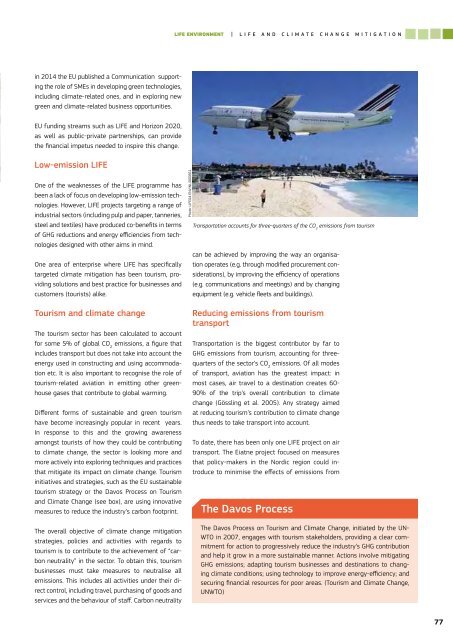You also want an ePaper? Increase the reach of your titles
YUMPU automatically turns print PDFs into web optimized ePapers that Google loves.
LIFE ENVIRONMENT |LIFE and Climate CHANGE mitigationin 2014 the EU published a Communication supportingthe role of SMEs in developing green technologies,including climate-related ones, and in exploring newgreen and climate-related business opportunities.EU funding streams such as LIFE and Horizon 2020,as well as public-private partnerships, can providethe financial impetus needed to inspire this change.Low-emission LIFEOne of the weaknesses of the LIFE programme hasbeen a lack of focus on developing low-emission technologies.However, LIFE projects targeting a range ofindustrial sectors (including pulp and paper, tanneries,steel and textiles) have produced co-benefits in termsof GHG reductions and energy efficiencies from technologiesdesigned with other aims in mind.One area of enterprise where LIFE has specificallytargeted climate mitigation has been tourism, providingsolutions and best practice for businesses andcustomers (tourists) alike.Photo: LIFE04 ENV/NL/000661Transportation accounts for three-quarters of the CO 2emissions from tourismcan be achieved by improving the way an organisationoperates (e.g. through modified procurement considerations),by improving the efficiency of operations(e.g. communications and meetings) and by changingequipment (e.g. vehicle fleets and buildings).Tourism and climate changeThe tourism sector has been calculated to accountfor some 5% of global CO 2emissions, a figure thatincludes transport but does not take into account theenergy used in constructing and using accommodationetc. It is also important to recognise the role oftourism-related aviation in emitting other greenhousegases that contribute to global warming.Different forms of sustainable and green tourismhave become increasingly popular in recent years.In response to this and the growing awarenessamongst tourists of how they could be contributingto climate change, the sector is looking more andmore actively into exploring techniques and practicesthat mitigate its impact on climate change. Tourisminitiatives and strategies, such as the EU sustainabletourism strategy or the Davos Process on Tourismand Climate Change (see box), are using innovativemeasures to reduce the industry’s carbon footprint.The overall objective of climate change mitigationstrategies, policies and activities with regards totourism is to contribute to the achievement of “carbonneutrality” in the sector. To obtain this, tourismbusinesses must take measures to neutralise allemissions. This includes all activities under their directcontrol, including travel, purchasing of goods andservices and the behaviour of staff. Carbon neutralityReducing emissions from tourismtransportTransportation is the biggest contributor by far toGHG emissions from tourism, accounting for threequartersof the sector’s CO 2emissions. Of all modesof transport, aviation has the greatest impact: inmost cases, air travel to a destination creates 60-90% of the trip’s overall contribution to climatechange (Gössling et al. 2005). Any strategy aimedat reducing tourism’s contribution to climate changethus needs to take transport into account.To date, there has been only one LIFE project on airtransport. The Eiatne project focused on measuresthat policy-makers in the Nordic region could introduceto minimise the effects of emissions fromThe Davos ProcessThe Davos Process on Tourism and Climate Change, initiated by the UN-WTO in 2007, engages with tourism stakeholders, providing a clear commitmentfor action to progressively reduce the industry’s GHG contributionand help it grow in a more sustainable manner. Actions involve mitigatingGHG emissions; adapting tourism businesses and destinations to changingclimate conditions; using technology to improve energy-efficiency; andsecuring financial resources for poor areas. (Tourism and Climate Change,UNWTO)77


